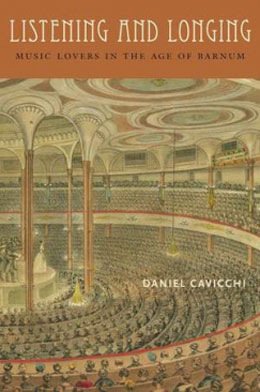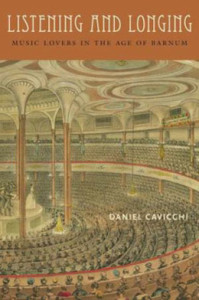How Americans Learned to Listen

Flipping idly through the end of this book, noting the dozens of titles published in Wesleyan’s Music/Culture series (to which Listening and Longing is a recent addition), I was struck by the exotic scenes and subcultures under investigation: Romani music of Greek Macedonia, Wangga music of North Australia, underground dance music in NYC, Moroccan Ganawa trance music, hip hop from Down Under, salsa from Cali, Colombia. Daniel Cavicchi’s historical subjects, mainly northern U.S. urban-dwelling white middle-class aspiring music lovers in the middle decades of the nineteenth century, seem relatively familiar and bland in comparison.
Then there is Ossian E. Dodge, introduced in the first chapter. A self-made jack of all trades—novelty vocalist, writer of comic songs, editor of small magazines—and P.T. Barnum manqué, Dodge achieved national celebrity in 1850 by bidding $625 in a Boston auction to purchase a ticket to a concert by Jenny Lind, “the Swedish Nightingale,” probably the biggest musical phenomenon to hit America in the nineteenth century. This sum was well beyond his means and $400 more than was bid in a similar auction in New York City, also organized by the tour’s sponsor, Barnum himself. Dodge seized on the buzz generated by his inexplicable munificence to commission a lithograph of an imaginary scene depicting himself being introduced to Lind by Barnum. He then leveraged this newfound celebrity to promote his own short-lived career as a singer of strange songs before he left the arts for greener pastures, eventually settling in St. Paul, Minnesota, wealthy from real estate.
As Cavicchi explains it, a figure like Dodge could only have arisen in the burgeoning world of commercial music made possible by the market revolution of the 1820s and 1830s. “Dodge, the hustling ‘Boston vocalist,’ was part of a passing generation,” he writes, “but Dodge, the music-loving ticket bidder, was a symbol of the future” (39). Previously music had been a mostly amateur endeavor, confined mainly to churches and homes, with the occasional street parade. As the century wore on, commercial music figured increasingly in the musical lives of Americans, significantly multiplying the choices available to audiences and elevating their aesthetic sophistication. “The first music lovers, as witnesses to the beginnings of the commercialization of culture in the nineteenth century,” Cavicchi asserts, “were among the earliest to assume the role of the audience-consumer and to create the strategies many use today for understanding the world of stars, merchandizing, and spectacle” (185).
At one level the book offers a conventional history of how the market revolution reshaped social life and popular culture in the nineteenth century. New forms of capitalist enterprise seduced young people from family farms and small communities to expanding cities. Industrial development drove the expansion of railroad networks, which in turn made it easier for musicians to tour distant cities and reach larger audiences. Before the 1820s, musical life even in urban areas was hit or miss. But entertainment of all types was increasingly available in public venues, usually for a price. Many of Cavicchi’s sources are young clerks who recorded their wide-eared wonder at the variety of sounds available to them in city streets. Some subjects are famous, like George Templeton Strong and Walt Whitman, who roamed the streets feasting indiscriminately on an eclectic sonic diet of street parades, concerts, sermons, and opera. These pioneering music lovers sought out the musical riches proffered by entrepreneurs in pleasure gardens, concert halls, and theaters, using their burgeoning musical awareness as a means of fashioning a new kind of urban identity. African Americans and women were also drawn to the musical riches, but were constrained by pervasive northern racism and the “cult of true womanhood,” which limited the public activity of single women.
Cavicchi presents the social context effectively to support his claims about changes in what he calls “audiencing.” But the real interest and originality of the book lies in how it probes the inner lives of individual men and women drawn to music. The development of a “musical ear” gradually became an important marker of middle-class refinement as well as a means of emotional expression. After the Civil War, for the new cohort of more sophisticated music listeners, it was not enough to simply listen to and appreciate, as Whitman did, a wide variety of musical sounds. It became increasingly important to make discriminations, to know which composers or performers were worthy of admiration and might increase one’s social capital. By the final decades of the century, according to Cavicchi, urban music audiences were dividing between refined listeners and those drawn to spectacle and celebrity.
Of particular interest is the final chapter, which canvasses critical public reactions to these passionate music lovers. Listeners who responded too ecstatically to the performances and persona of Jenny Lind in the 1850s, or to the operas of Richard Wagner in the 1880s, were suspected of harboring tendencies toward psychic instability, “monomania.” Excessive enthusiasm was also denigrated as a sign of a lack of refinement, of an unseemly, even dangerous mob mentality, or of a suspiciously feminine, passive, and over-emotional nature. Critics found grist for acerbic cartoons and published satires in “Lindmania,” over-the-top Wagner devotees (the source of the term “long-hair” as applied to classical music intellectuals), and the “Monster Concerts for the Masses” in vogue after the Civil War that featured orchestras of 2,000 and choruses of 20,000 (including thousands of school children). Guest composer Johann Strauss wrote of the 1872 World Peace Jubilee in Boston:
Now just conceive of my position face to face with a public of four hundred thousand Americans. There I stood at the raised desk, high above all the others. How would the business start, how would it end? Suddenly a cannon-shot rang out a gentle hint for us twenty thousand to begin playing The Blue Danube. I gave the signal, my hundred assistant conductors followed me as quickly as well as they could, and then there broke out an unholy row such as I shall never forget (120).
A man living 26 miles outside Boston knew when the “Anvil Chorus” was being played by listening for the sound of the cannon.
To write a book about as private an experience as listening to music requires major sleuthing. It’s one thing to track down published reviews by professional critics, another to access the reactions of lay listeners. According to Cavicchi, other historians have tried but given up for lack of evidence. Perusing dozens of unpublished journals in a kind of needle-in-a-haystack quest, he made some lucky finds. Especially intriguing are the embossed leather-bound sheet music binders kept by amateur women pianists. Containing years’ worth of deeply personalized sheet music—often given by friends or suitors, carefully indexed, sometimes annotated with detailed marginal comments—these binders provide a fascinating window into the musical lives of nineteenth-century women who created music in the home. “Music lovers used diaries not simply as tools, but as stand-ins, indices, for music performances themselves,” he concludes, and the diaries helped them relive their musical pleasure in an era before sound recordings (135).
A particularly rich source is Lucy Lowell, an intelligent and independent woman who developed into a quintessential music lover whose life revolved around the schedule of the Boston Symphony Orchestra. Born in 1860 to one of the storied families of New England, raised in the Boston suburb of Chestnut Hill, she filled seven volumes of her diary during her twenties with detailed and exacting commentary on musical performances, including two tours of Europe during which she saw Wagner performed at the Vienna Opera House and at Bayreuth. Of an Italian production of Barber of Seville she saw in Boston: “Gerster was utterly, entirely perfectly bewitching … You get a good idea of her genius by seeing her first in ‘Lucia’ & then in ‘The Barber,’ for two more different parts can’t be imagined & when you see how exquisitely she does them both, you appreciate her power” (115).
How do we reconcile this highly refined aesthetic sensibility with the crass tone-deaf self-promotion of an impresario like Ossian Dodge, whom Cavicchi early on states represented the wave of the future? Listening and Longing posits a bifurcation into “two different kinds of music engagement in the twentieth century: one based on the intellectual ecstasies of inner contemplation, fostered and supported by the performance of ‘good music,’ and one based on passionate participation in the world of stars, spectacle and collecting, relegated to the realm of ‘popular’ culture. While music lover continued to be used to refer to enthusiastic patrons of classical music, practitioners of the older form of music loving were given a new name taken from sports: fans” (184).
One can immediately think of audiences that straddle and destabilize these categories, like jazz fans and devotees of the 1960s Folk Revival. But do we really need the term “audiencing” for this argument to work? The beauty of influential musicologist Christopher Small’s concept of “musicking” was that analyzing music through the gestalt of social practice dissolves many of the false binaries that have crept into the academic study of music—between composer and musician, performer and audience, text and context. The activities that Cavicchi highlights through “audiencing” are already present in Small’s more capacious category of “musicking.” (His book is titled Musicking: The Meanings of Performing and Listening.) “Whatever it is we are doing,” Small writes, “we are all doing it together—performers, listeners (should there be any apart from the performers), composer (should there be one apart from the performers), dancers, ticket collectors, piano movers, roadies, cleaners and all” (Musicking, 10). In effect, then, Cavicchi reinscribes a dichotomy, between “musicking” and “audiencing,” that Small helped us think beyond. Regardless, this is a well-researched, elegant and thought-provoking book.
This article originally appeared in issue 13.2 (Winter, 2013).
David W. Stowe is a 2012-13 research fellow at Yale’s Institute of Sacred Music, writing a book about Psalm 137 in American music.
